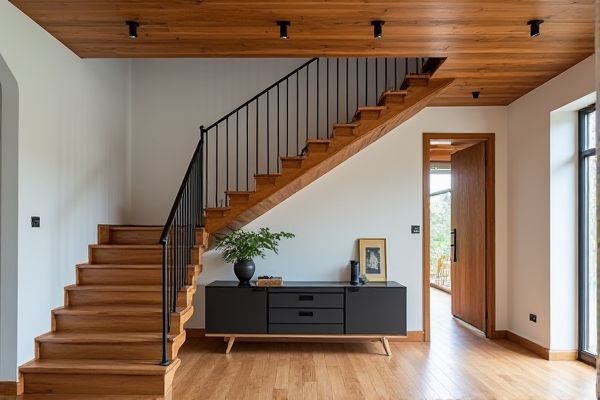
Wooden staircases offer a warm, classic aesthetic with natural textures that enhance interior design, while metal staircases provide modern durability, minimal maintenance, and a sleek industrial look. Discover which material best suits Your space and lifestyle by exploring the full comparison in this article.
Table of Comparison
| Feature | Wooden Staircase | Metal Staircase |
|---|---|---|
| Material | Natural wood (oak, maple, pine) | Steel, aluminum, wrought iron |
| Durability | Moderate; prone to scratches and moisture damage | High; resistant to corrosion and heavy use |
| Maintenance | Requires regular polishing and treatment | Low maintenance; occasional rust prevention needed |
| Cost | Generally affordable; varies with wood type | Tends to be more expensive due to material and fabrication |
| Design Flexibility | Traditional, warm aesthetic; limited shapes | Modern, sleek designs; customizable shapes and sizes |
| Weight | Lighter than metal; easier to install | Heavier; requires stronger structural support |
| Fire Resistance | Low; wood is combustible | High; metal is non-combustible |
| Noise | Quieter; absorbs sound better | Louder; metal creaks under pressure |
Introduction to Wooden and Metal Staircases
Wooden staircases offer natural warmth, durability, and classic aesthetic appeal through materials like oak, maple, and pine, ideal for residential designs. Metal staircases, constructed from steel, aluminum, or wrought iron, provide superior strength, modern style, and enhanced fire resistance, making them suitable for both industrial and contemporary architecture. Choosing between wooden and metal staircases depends on factors such as structural requirements, maintenance preferences, and desired visual impact.
Material Composition and Durability
Wooden staircases, crafted from hardwoods like oak, maple, or cherry, offer natural warmth and aesthetic appeal but may require regular maintenance to prevent issues like warping or termite damage. Metal staircases, typically made from steel or aluminum, provide superior durability, resistance to weather, and require less upkeep due to their corrosion-resistant properties. The choice between wood and metal significantly impacts the longevity and maintenance needs of the staircase, with metal generally outperforming wood in durability under harsh conditions.
Aesthetic Appeal: Wood vs. Metal
Wooden staircases offer a warm, natural aesthetic with rich textures and grains that complement traditional and rustic interior designs. Metal staircases provide a sleek, modern look characterized by clean lines and industrial finishes, ideal for contemporary spaces. The choice between wood and metal ultimately depends on the desired visual impact and architectural style of the space.
Installation Process and Time
Wooden staircases typically require more precise craftsmanship and can take longer to install, often ranging from several days to a few weeks depending on design complexity. Metal staircases benefit from prefabricated components, allowing for faster assembly, usually within a few days to one week. Installation time for metal staircases is often shorter due to standardized parts and fewer on-site modifications.
Cost Comparison: Upfront and Long-Term
Wooden staircases typically have a lower upfront cost due to readily available materials and simpler installation processes. Metal staircases, while more expensive initially, offer greater durability and lower maintenance costs over time, often resulting in better long-term value. Budget considerations should balance immediate expenses with anticipated maintenance and lifespan for both materials.
Maintenance Requirements
Wooden staircases require regular sealing, polishing, and protection from moisture and pests to maintain their durability and appearance. Metal staircases are generally low-maintenance, needing occasional cleaning and rust prevention treatments to avoid corrosion. Your choice depends on how much time and effort you want to invest in upkeep and the environmental conditions of your space.
Customization and Design Flexibility
Wooden staircases offer extensive customization with the ability to easily carve intricate details, choose from various wood types, and apply diverse finishes to match your interior style. Metal staircases provide superior design flexibility by enabling sleek, modern shapes and open-riser designs that support creative architectural expressions. Your choice depends on whether you prioritize warm, traditional aesthetics or contemporary, industrial design possibilities.
Safety and Structural Integrity
Wooden staircases offer natural slip resistance due to their textured surfaces but require regular maintenance to prevent rot and warping, which can compromise safety over time. Metal staircases provide superior structural integrity with higher load-bearing capacity and resistance to environmental factors such as moisture and insects, reducing long-term safety risks. Both materials must adhere to building codes and standards to ensure optimal safety and durability in their construction and installation.
Environmental Impact and Sustainability
Wooden staircases offer a renewable and biodegradable option, especially when sourced from certified sustainable forests, reducing your carbon footprint. Metal staircases, often made from recyclable materials like steel or aluminum, provide longevity and can be repurposed, but their production is typically energy-intensive with higher emissions. Choosing wood supports lower embodied energy and enhances sustainability, while metal demands careful consideration of lifecycle impacts and recycling efficiency.
Choosing the Right Staircase for Your Home
Wooden staircases offer warmth, natural beauty, and customization options ideal for traditional or rustic home designs, while metal staircases provide durability, modern aesthetics, and require less maintenance, making them suitable for contemporary spaces. Your choice depends on factors like interior style, budget, and maintenance preferences, with wood enhancing coziness and metal emphasizing sleek minimalism. Consider weight capacity and noise levels as metal stairs tend to be sturdier but may produce more sound compared to the softer feel of wood.
 homyna.com
homyna.com